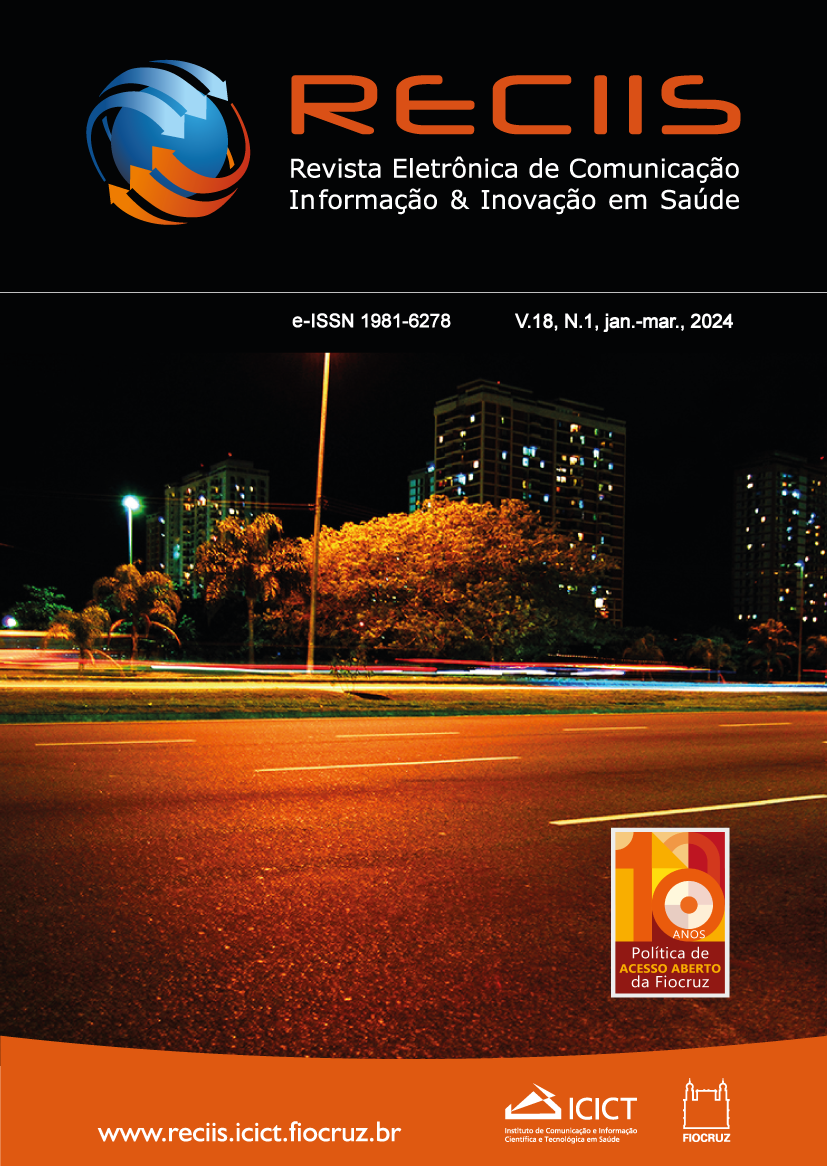Nomophobia and the pandemic: a study on the fear of being disconnected in Brazil
DOI:
https://doi.org/10.29397/reciis.v18iAhead-of-Print.3506Keywords:
Nomophobia, Smartphone, Internet access , Pandemic, Covid-19Abstract
The Information and Communication Technologies are present in human life. They offer many advantages, but they can also cause problems, among them nomophobia – anguish and fear of becoming incommunicado, without access to a smartphone or internet. To assess the degree of nomophobia, the Nomophobia Questionnaire (NMP-Q) was created. The objective of this article was to evaluate to what extent the social isolation proposed as a preventive measure against covid-19 interfered in the indices of nomophobia in Brazil. An adapted version of NMP-Q was applied to young people through digital media during the pandemic. The results indicate social isolation interfered with the increase of nomophobia, especially in women aged 20 to 29 and 50 to 59 years, with university degree or post-graduation and earning 10 to 20 minimum wages. This article is part of a set of international studies that used the NMP-Q to assess the fear of being disconnected.
References
ADAWI, Mohammad et al. Translation and validation of the Nomophobia Questionnaire in the Italian language: exploratory factor analysis. JMIR mHealth and uHealth, Toronto, v. 6, n. 1, p. e24, 2018. DOI: https://doi.org/10.2196/mhealth.9186. Disponível em: https://mhealth.jmir.org/2018/1/e24/. Acesso em: 27 out. 2023.
AL-BALHAN, Eisa M. et al. Psychometric evaluation of the Arabic version of the nomophobia questionnaire: confirmatory and exploratory factor analysis – implications from a pilot study in Kuwait among university students. Psychology Research and Behavior Management, Auckland, v. 11, p. 471-482, 2018. DOI: https://doi.org/10.2147/PRBM.S169918. Disponível em: https://www.dovepress.com/psychometric-evaluation-of-the-arabic-version-of-the-nomophobia-questi-peer-reviewed-fulltext-article-PRBM. Acesso em: 27 out. 2023.
ALVES, Giovana Santos; FARIAS, Fabiane Moreira. A síndrome de Burnout em tempos de estudo remoto. In: SALÃO INTERNACIONAL DE ENSINO, PESQUISA E EXTENSÃO, 12., 24-26 nov. 2023, online. Anais [...], Bagé, v. 12, n. 2, p. 1, 2020. Disponível em: https://periodicos.unipampa.edu.br/index.php/SIEPE/article/view/107131. Acesso em: 9 jan. 2023.
ARRAIS, Tadeu Alencar et al. Celeiros da pobreza urbana: suplementação de renda e isolamento social em ambientes metropolitanos nos tempos pandêmicos. Vigilância Sanitária em Debate: Sociedade, Ciência & Tecnologia, Rio de Janeiro, v. 8, n. 3, p. 11-25, 2020. DOI: https://doi.org/10.22239/2317-269x.01609. Disponível em: https://visaemdebate.incqs.fiocruz.br/index.php/visaemdebate/article/view/1609. Acesso em: 27 out. 2023.
BEZERRA, Anselmo César Vasconcelos et al. Fatores associados ao comportamento da população durante o isolamento social na pandemia de covid-19. Ciência & Saúde Coletiva, Rio de Janeiro, v. 25, suppl.1, p. 2411-2421, 2020. DOI: https://doi.org/10.1590/1413-81232020256.1.10792020. Disponível em: https://www.scielo.br/j/csc/a/9g4hLHkSSW35gYsSpggz6rn/?format=pdf&lang=pt. Acesso em: 27 out. 2023.
BOCKORNI, Beatriz Rodrigues Silva; GOMES, Almiralva Ferraz. A amostragem em snowball (bola de neve) em uma pesquisa qualitativa no campo da administração. Revista de Ciências Empresariais da UNIPAR, Umuarama, v. 22, n. 1, p. 105-117, 2021. DOI: https://doi.org/10.25110/receu.v22i1.8346. Disponível em: https://www.revistas.unipar.br/index.php/empresarial/article/view/8346. Acesso em: 27 out. 2023.
BOECHAT, Dayana. Nomofobia e pandemia: um estudo sobre o comportamento on-line no Brasil. 2021. 112f. Dissertação (Mestrado em Informação e Comunicação em Saúde) – Instituto de Comunicação e Informação Científica e Tecnológica em Saúde, Fundação Oswaldo Cruz, Rio de Janeiro, 2021. Disponível em: https://www.arca.fiocruz.br/handle/icict/50695. Acesso em: 18 dez. 2023.
BORGES, Luana de Andrade Pinheiro; TEIXEIRA, Thelma Pignataro. Nomofobia: uma síndrome do século XXI. Interface: Revista do Centro de Ciências Sociais Aplicadas, Natal, v. 13, n. 1, p. 121-132, 2016. Disponível em: http://www.spell.org.br/documentos/ver/43166/nomofobia--uma-sindrome-no-sec--xxi-.%20Acesso%20em:%2027%20out.%202023. Acesso em: 18 dez. 2023.
COELHO, Leda Rúbia Maurina; OLIVEIRA, Margareth da Silva. Avaliação dos comportamentos dependentes. Aletheia, Canoas, n. 43-44, p. 248-251, ago. 2014. Disponível em: http://pepsic.bvsalud.org/scielo.php?script=sci_arttext&pid=S1413-03942014000100019. Acesso em: 27 out. 2023.
COMOLI, Eliane; CANTO, Karen. Pandemia impacta mais a vida das mulheres. Unicamp, Campinas, 18 ago. 2020. Cultura e Sociedade Lab-19. Disponível em: https://www.unicamp.br/unicamp/noticias/2020/08/19/pandemia-impacta-mais-vida-das-mulheres. Acesso em: 18 set. 2023.
CRODA, Julio Henrique Rosa; GARCIA, Leila Posenato. Resposta imediata da Vigilância em Saúde à epidemia da covid-19. Epidemiologia e Serviços de Saúde, Brasília, DF, v. 29, n. 1, p. 1-3, 2020. DOI: https://doi.org/10.5123/S1679-49742020000100021. Disponível em: https://www.scielosp.org/article/ress/2020.v29n1/e2020002/pt/. Acesso em: 27 out. 2023.
EISENSTEIN, Evelyn.; SILVA, Eduardo Jorge Custódio Crianças e adolescentes na internet: um perfil atual dos riscos no Brasil. In: PEREIRA NETO, Andre; FLYNN, Michael B. (ed.). Internet e saúde no Brasil: desafios e tendências. São Paulo: Cultura Acadêmica, 2021. p. 292-311.
FILGUEIRAS, Alberto; STULTS-KOLEHMAINEN, Matthew. Risk factors for potential mental illness among Brazilians in quarantine due to covid-19. Psychological Reports, Thousand Oaks, v. 125, n. 2, p. 723-741, 2021. DOI: https://doi.org/10.1177/0033294120976628. Disponível em: https://pubmed.ncbi.nlm.nih.gov/33567978/. Acesso em: 27 out. 2023.
FOGAÇA, Priscila Carvalho; AROSSI, Guilherme Anzilero; HIRDES, Alice. Impacto do isolamento social ocasionado pela pandemia covid-19 sobre a saúde mental da população em geral: uma revisão integrativa. Research, Society and Development, São Paulo, v. 10, n. 4, p. e52010414411, p. 1-14, 2021. DOI: http://dx.doi.org/10.33448/rsd-v10i4.14411. Disponível em: https://rsdjournal.org/index.php/rsd/article/view/14411. Acesso em: 27 out. 2023.
GAO, Ye et al. Translation of the Chinese version of the nomophobia questionnaire and its validation among college students: factor analysis. JMIR mHealth and uHealth, Toronto, v. 8, n. 3, p. e13561, 2020. DOI: https://doi.org/10.2196/13561. Disponível em: https://mhealth.jmir.org/2020/3/e13561/. Acesso em: 27 out. 2023.
GARRIDO, Rodrigo Grazinoli; RODRIGUES, Rafael Coelho. Restrição de contato social e saúde mental na pandemia: possíveis impactos das condicionantes sociais. Journal of Health and Biological Sciences, Fortaleza, v. 8, n. 1, p. 1-9, 2020. DOI: https://doi.org/10.12662/2317-3076jhbs.v8i1.3325.p1-9.2020. Disponível em: https://periodicos.unichristus.edu.br/jhbs/article/view/3325. Acesso em: 27 out. 2023.
GONZÁLEZ-CABRERA, Joaquin. et al. Adaptation of the Nomophobia Questionnaire (NMP-Q) to Spanish in a sample of adolescents. Actas Espanolas de Psiquiatria, Madrid, v. 45, n. 4, p. 137-181, 2017. Disponível em: https://www.researchgate.net/publication/318852218_Original_Adaptation_of_the_Nomophobia_Questionnaire_NMP-Q_to_Spanish_in_a_sample_of_adolescents. Acesso em: 27 out. 2023.
INSTITUTO BRASILEIRO DE GEOGRAFIA E ESTATÍSTICA (IBGE). Censo 2010. Rio de Janeiro: IBGE, 2010. Disponível em: https://censo2010.ibge.gov.br/. Acesso em: 8 jan. 2023.
KING, Anna Lucia Spear; NARDI, Antonio Egídio. O que é Nomofobia? Histórico e conceito. In: KING, Anna Lucia Spear; NARDI, Antonio Egídio; CARDOSO, Adriana. (org.). Nomofobia: dependência do computador, internet, redes sociais? Dependência do telefone celular?. Rio de Janeiro: Atheneu Editora, 2014. p. 1- 28.
KUSS, Daria J.; GRIFFITHS, Mark D. Social networking sites and addiction: ten lessons learned. International Journal of Environmental Research and Public Health, Basel, v. 14, n. 3, p. 311, 2017. DOI: https://doi.org/10.3390/ijerph14030311. Disponível em: https://www.mdpi.com/1660-4601/14/3/311. Acesso em: 27 out. 2023.
LEITE, R. J. L. et al. É possível sobreviver sem o celular? Uma revisão bibliográfica sobre o tema nomofobia. Revista Espacios, Caracas, v. 41, n. 3, p. 1-6, 2020. Disponível em: https://www.revistaespacios.com/a20v41n03/a20v41n03p11.pdf. Acesso em: 27 out. 2023.
LEÓN-MEJÍA, Ana C. et al. A systematic review on nomophobia prevalence: Surfacing results and standard guidelines for future research. PLoS ONE, São Francisco, v. 16, n. 5, p. e0250509, 2021. DOI: https://doi.org/10.1371/journal.pone.0250509. Disponível em: https://journals.plos.org/plosone/article?id=10.1371/journal.pone.0250509. Acesso em: 18 dez. 2023.
LIN, Chung-Ying; GRIFFITHS, Mark D.; PAKPOUR, Amir H. Psychometric evaluation of Persian Nomophobia Questionnaire: Differential item functioning and measurement invariance across gender. Journal of Behavioral Addictions, Budapeste, v. 7, n. 1, p. 100-108, 2018. DOI: https://doi.org/10.1556/2006.7.2018.11. Disponível em: https://akjournals.com/view/journals/2006/7/1/article-p100.xml. Acesso em: 27 out. 2023.
LOURENÇO, Camilo Monteiro et al. Nomofobia: o vício em gadgets pode ir muito além! Multi-Science Journal, Urutaí, v. 1, n. 3, p. 53-55, 2015. DOI: https://doi.org/10.33837/msj.v1i3.118. Disponível em: https://periodicos.ifgoiano.edu.br/multiscience/article/view/118. Acesso em: 27 out. 2023.
MAZIERO, Mari Bela; OLIVEIRA, Lisandra Antunes de. de. Nomofobia: uma revisão bibliográfica. Unoesc & Ciência – ACBS, Joaçaba, v. 8, n. 1, p. 73-80, 2017. Disponível em: https://periodicos.unoesc.edu.br/acbs/article/view/11980. Acesso em: 27 out. 2023.
NABUCO, Guilherme; OLIVEIRA, Maria Helena Pereira Pires de; AFONSO, Marcelo Pellizzaro Dias. O impacto da pandemia pela covid-19 na saúde mental: qual é o papel da Atenção Primária à Saúde? Revista Brasileira de Medicina de Família e Comunidade, Rio de Janeiro, v. 15, n. 42, p. 2532, 2020. DOI: https://doi.org/10.5712/rbmfc15(42)2532. Disponível em: https://rbmfc.org.br/rbmfc/article/view/2532. Acesso em: 27 out. 2023.
NAWAZ, Irfan et al. Measuring the enormity of nomophobia among youth in Pakistan. Journal of Technology in Behavioral Science, [s. l.], v. 2, p. 149-155, 2017. DOI: https://doi.org/10.1007/s41347-017-0028-0. Disponível em: https://link.springer.com/article/10.1007/s41347-017-0028-0. Acesso em: 27 out. 2023.
NÚCLEO DE INFORMAÇÃO E COORDENAÇÃO DO PONTO BR (ed.). TIC Domicílios: Pesquisa sobre o uso das Tecnologias de Informação e Comunicação nos domicílios brasileiros – 2020. São Paulo: Comitê Gestor da Internet no Brasil, 2021. Disponível em: https://cetic.br/media/docs/publicacoes/2/20211124201233/tic_domicilios_2020_livro_eletronico.pdf. Acesso em: 27 out. 2023.
PEREIRA NETO, André; BARBOSA, Leticia; FLYNN, Michael B. Prefácio da edição brasileira – Há décadas em que nada acontece. Há semanas em que décadas acontecem. In: PEREIRA NETO, Andre; FLYNN, Michael B. (ed.). Internet e saúde no Brasil: desafios e tendências. São Paulo: Cultura Acadêmica, 2021. p. 7-18.
ROCHA, Hermano Alexandre Lima et al. Adaptação transcultural e validação do Nomophobia Questionnaire (NMP- Q) para a língua portuguesa (NMP-Q-BR). Journal of Health & Biological Sciences, Fortaleza, v. 8, n. 1, p. 1-6, 2020. DOI: https://doi.org/10.12662/2317-3076jhbs.v8i1.3052.p1-6.2020. Disponível em: https://periodicos.unichristus.edu.br/jhbs/article/view/3052. Acesso em: 27 out. 2023.
SANTOS, Iraneide Nascimento dos et al. Isolamento social e seus impactos na saúde mental: uma revisão. Research, Society and Development, v. 10, n. 8, p. 1-11, 2021. DOI: http://dx.doi.org/10.33448/rsd-v10i8.17206. Disponível em: https://rsdjournal.org/index.php/rsd/article/view/17206../../../../../maria/Desktop/17206-Article-220001-1-10-20210711.pdf. Acesso em: 27 out. 2023.
SILVA, Paulo Gregório Nascimento da et al. Nomophobia Questionnaire: propriedades psicométricas para o contexto brasileiro. Revista Iberoamericana de Diagnóstico y Evaluación – e Avaliação Psicológica: RIDEP, Lisboa, v. 2, n. 55, p. 161-172, 2020. DOI: https://doi.org/10.21865/RIDEP55.2.12. Disponível em: https://www.redalyc.org/journal/4596/459664449013/459664449013.pdf. Acesso em: 27 out. 2023.
TENÓRIO, Ricardo Jorge Medeiros. A saúde mental e ergonômica no trabalho remoto no pós-pandemia. Revista Espaço Acadêmico, Maringá, v. 20, p. 96-105, 2021. Disponível em: https://periodicos.uem.br/ojs/index.php/EspacoAcademico/article/view/58092. Acesso em: 27 out. 2023.
THEODORSON, George A. A modern dictionary of sociology. North Yorkshire: Methuen, 1970.
VIEIRA, Pâmela Rocha; GARCIA, Leila Posenato; MACIEL, Ethel Leonor Noia. Isolamento social e o aumento da violência doméstica: o que isso nos revela?. Revista Brasileira de Epidemiologia, São Paulo, v. 23, p. 1-5, 2020. DOI: https://doi.org/10.1590/1980-549720200033. Disponível em: https://www.scielo.br/j/rbepid/a/tqcyvQhqQyjtQM3hXRywsTn/?format=pdf&lang=pt. Acesso em: 27 out. 2023.
VINUTO, Juliana. A amostragem em bola de neve na pesquisa qualitativa: um debate em aberto. Tematicas, Campinas, v. 22, n. 44, p. 203-220, 2014. DOI: https://doi.org/10.20396/tematicas.v22i44.10977. Disponível em: https://econtents.bc.unicamp.br/inpec/index.php/tematicas/article/view/10977/6250. Acesso em: 27 out. 2023.
WORLD HEALTH ORGANIZATION (WHO). Coronavirus disease 2019 (COVID-19): Situation Report – 79. Genebra: OMS, n. 79, 8 abr. 2020. Disponível em: https://www.who.int/docs/default-source/coronaviruse/situation-reports/20200408-sitrep-79-covid-19.pdf. Acesso em: 18 set. 2023.
YILDIRIM, Caglar; CORREIA, Ana-Paula. Exploring the dimensions of nomophobia: Development and validation of a self-reported questionnaire. Computers in Human Behavior, [s. l.], v. 49, p. 130-137, 2015. DOI: https://doi.org/10.1016/j.chb.2015.02.059. Disponível em: https://www.sciencedirect.com/science/article/pii/S0747563215001806. Acesso em: 27 out. 2023.
YILDIRIM, Caglar et al. A growing fear: prevalence of nomophobia among Turkish college students. Information Development, [s. l.], v. 32, n. 5, p. 1322-1331, 2016. DOI: https://doi.org/10.1177/026666691559902. Disponível em: https://journals.sagepub.com/doi/10.1177/0266666915599025. Acesso em: 27 out. 2023.
Downloads
Published
How to Cite
Issue
Section
License
Copyright (c) 2024 Dayana Boechat, André Pereira Neto, Leticia Barbosa

This work is licensed under a Creative Commons Attribution-NonCommercial 4.0 International License.
Author’s rights: The author retains unrestricted rights over his work.
Rights to reuse: Reciis adopts the Creative Commons License, CC BY-NC non-commercial attribution according to the Policy on Open Access to Knowledge by Oswaldo Cruz Foundation. With this license, access, download, copy, print, share, reuse, and distribution of articles is allowed, provided that it is for non-commercial use and with source citation, granting proper authorship credits and reference to Reciis. In such cases, no permission is required from the authors or editors.
Rights of authors’s deposit / self-archiving: The authors are encouraged to deposit the published version, along with the link of their article in Reciis, in institutional repositories.












